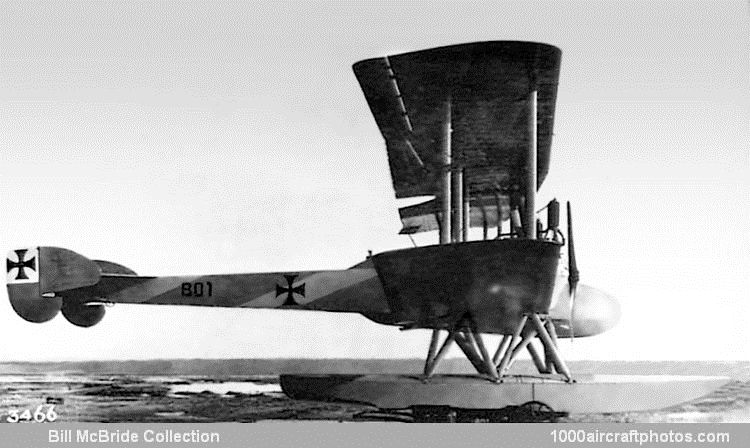12/29/2014. Remarks by Johan Visschedijk: "Although the Gothaer Waggonfabrik (Gotha Railcar Factory) was principally famous for its twin-engined bombers, it also produced some eighteen types of twin-float seaplane. The majority were no more than one-off prototypes, and apart from a small production batch of thirteen WD 11s, the only seaplane to be produced in any quantity was the twin-engined WD 14. This aircraft had been designed as a torpedo attack machine, and some sixty-nine examples were built.
The WD 14 was developed from the earlier, and smaller, WD 7 and WD 11 prototypes and conformed to an orthodox layout. The fuselage was basically a rectangular braced box-girder of spruce longerons and spacers with fabric-wrapped plywood-veneer covering. A rounded decking was incorporated on top of the fuselage forward and also underneath (as far aft as the trailing edge) to partially fair-in the torpedo slung under the belly in a special dropping gear. The pilot was located back under the wings, side-by-side with the torpedo-man, who went forward to the nose cockpit to control the actual release of the missile. An additional gunner's cockpit was located behind the pilot. The long two-step floats were carried on a complex strut chassis, designed without any spreader struts or wires between the floats to allow the torpedo to fall clear. Each float chassis therefore had to be an independent structure.
The angular tail plane was attached to the top longerons and was fitted with a one-piece, unbalanced elevator. Twin fins and twin horn-balanced rudders gave the empennage a distinctive profile; these surfaces were mounted as "end plates" on the extremities of the tail plane, extending both above and below, and were braced with light steel-tube struts. One aircraft also had a center fin. The center section of the three-bay wing structure embraced the mounting of the two 200 hp Benz Bz IV six-cylinder liquid-cooled in-line engines which were located directly on the lower wing as normal tractor units. The engines were additionally braced to the wing spars with streamlined steel-tube struts. Large frontal radiators were slung well above the cylinder-heads, and the engines themselves were well cowled in except for the upper part of the cylinders. A generous cut-out was made in the upper center section in an endeavor to improve the pilot's upward field of vision.
An unusual feature of the outer wing panels, which were arranged to fold from the center section, was the taper of some 5° on the leading edge only. The wings themselves were based on the conventional twin main spar structure, the spars also being angled back at some 5° and the spruce-flanged plywood ribs, of a high lift section, were closely spaced to ensure as little airfoil section loss as possible. The horn-balanced ailerons were hinged to an auxiliary spar parallel to the main spars.
No great success was achieved with torpedo attacks. The WD 14s were largely underpowered when loaded, and only pilots of exceptional skill were able to make suitable attack runs and torpedo drops from a height of some 20 to 30 ft (6 to 9 m). A long course of training had to be undergone by both pilot and torpedo-man, and eventual results in no way justified the efforts involved. After the first two torpedo attacks from North Sea bases and in the Gulf of Riga, the Allied counter-measures became so effective as to negate much chance of success. As a result, in the last year of the war, torpedo-carrying machines were abandoned, as losses far outweighed results. As defensive armament the type featured a manually operated Parabellum gun in the nose and in the rear cockpits.
In order not to waste useful airframes, torpedoplanes were modified to undertake long-range reconnaissance duties over the North Sea in an endeavor to find an efficient substitute for the airship, which, during 1917, had become too vulnerable. Jettisonable fuel tanks fitted in the torpedo slings enabled flights of upwards of ten hours to be achieved. The seaplanes were unable to remain airborne on one engine even after the auxiliary fuel tank had been discarded. On having to alight on any other than a near flat-calm surface, they soon broke up. They were also tried in the role of mine-layers without success, but before being given up altogether were employed for a short time as coastal convoy escorts."
